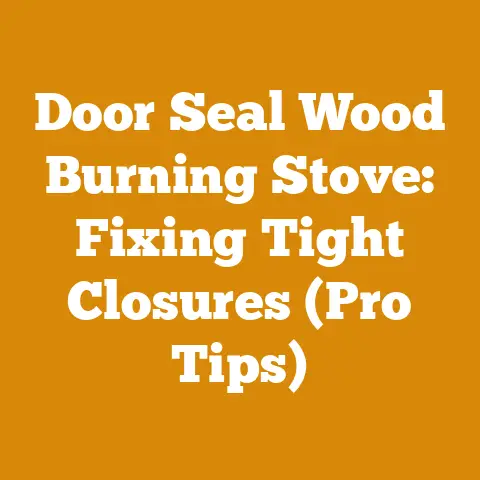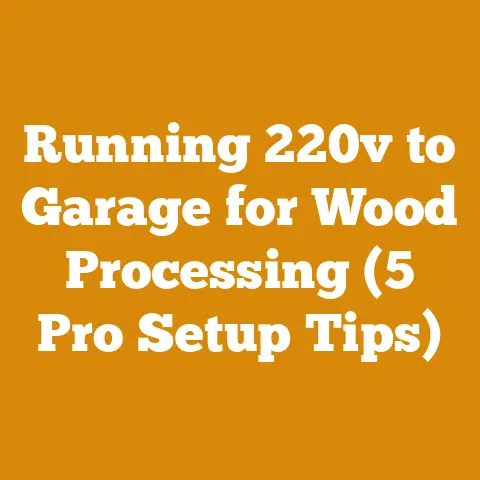Honda Excell 2600 Pressure Washer Pump Options (5 Expert Tips)
In the annals of cleaning history, the humble pressure washer holds a somewhat recent but powerful position. While rudimentary high-pressure cleaning systems existed in the late 19th century, it wasn’t until the mid-20th century that practical, portable pressure washers began to appear. Today, pressure washers are indispensable tools for homeowners and professionals alike. A key component of any pressure washer is, of course, the pump. This article will focus on Honda Excell 2600 pressure washer pump options and provide five expert tips to help you navigate the world of pressure washer pumps.
Honda Excell 2600 Pressure Washer Pump Options (5 Expert Tips)
The Honda Excell 2600 pressure washer is a popular choice for its balance of power and portability. However, like any mechanical device, the pump is subject to wear and tear. Understanding your pump options is crucial for maintaining your pressure washer and ensuring its longevity. I’ve spent years dealing with all sorts of wood processing equipment, from chainsaws to splitters, and I’ve learned that preventative maintenance and smart repairs are key to saving money and time in the long run. Think of a pressure washer pump like the heart of a tree – if it stops working, everything else suffers.
1. Identifying Your Pump Type and Replacement Needs
Before diving into specific pump options, it’s essential to identify the type of pump your Honda Excell 2600 pressure washer uses and why you might need a replacement. Most consumer-grade pressure washers, including the Excell 2600, utilize either an axial cam pump or a wobble plate pump.
- Axial Cam Pumps: These pumps are generally more compact and cost-effective. They use an angled plate (the axial cam) to drive the pistons. Axial cam pumps are common in lighter-duty pressure washers and are typically designed for shorter lifespans than more robust options.
- Wobble Plate Pumps: Wobble plate pumps, while still relatively compact, often offer improved durability compared to axial cam pumps. They utilize a wobbling plate mechanism to actuate the pistons.
Determining Your Pump Model:
The easiest way to determine your pump model is to check your pressure washer’s owner’s manual. The manual should list the pump manufacturer and model number. If you no longer have the manual, look for a sticker or plate on the pump itself. This often contains the model information.
Reasons for Pump Replacement:
- Loss of Pressure: This is the most common symptom of a failing pump. If your pressure washer is no longer producing the same pressure as it used to, the pump is likely the culprit.
- Leaks: Leaks around the pump housing or connections indicate worn seals or cracks in the pump body.
- Noise: Unusual noises, such as grinding or squealing, can signify internal pump damage.
- Pump Failure: In some cases, the pump may simply stop working altogether.
Cost Considerations:
Replacing a pressure washer pump can range from \$50 to \$200 or more, depending on the pump type and brand. Before deciding to replace the pump, consider the age and overall condition of your pressure washer. If the machine is several years old and has other issues, it might be more cost-effective to replace the entire unit. I remember once trying to fix a very old log splitter, replacing part after part, only to realize that I had spent more on repairs than a new splitter would have cost. Learn from my mistakes!
2. Exploring OEM and Aftermarket Pump Options
Once you’ve determined that you need to replace your pump, you have two main options: Original Equipment Manufacturer (OEM) pumps and aftermarket pumps.
- OEM Pumps: These are pumps manufactured by or for the original pressure washer manufacturer (in this case, Honda or a designated supplier). OEM pumps are designed to be a direct replacement for the original pump and should offer the best fit and performance.
- Aftermarket Pumps: These are pumps manufactured by third-party companies. Aftermarket pumps can be a more affordable alternative to OEM pumps, but it’s essential to choose a reputable brand and ensure compatibility with your Honda Excell 2600.
Advantages and Disadvantages:
| Feature | OEM Pump | Aftermarket Pump |
|---|---|---|
| Fit | Guaranteed direct replacement | May require slight modifications |
| Performance | Designed for optimal performance with your unit | Performance may vary |
| Price | Generally more expensive | Often more affordable |
| Warranty | Typically comes with a warranty | Warranty coverage may vary or be limited |
| Availability | May be harder to find, especially for older models | Usually readily available online or in stores |
Choosing the Right Option:
- Budget: If you’re on a tight budget, an aftermarket pump can be a viable option. However, prioritize quality and compatibility.
- Longevity: If you want the best possible performance and lifespan, an OEM pump is generally the better choice.
- Availability: Consider the availability of both OEM and aftermarket pumps. If you need a replacement quickly, an aftermarket pump might be easier to obtain.
My Recommendation:
For a Honda Excell 2600, I generally recommend sticking with an OEM pump if possible. While aftermarket options can save you money upfront, the potential for compatibility issues and reduced performance can lead to frustration and additional costs down the road. However, if an OEM pump is unavailable or prohibitively expensive, research aftermarket options carefully and choose a reputable brand with positive reviews.
3. Understanding Pump Specifications and Compatibility
When selecting a replacement pump, it’s crucial to understand the specifications and ensure compatibility with your Honda Excell 2600. Key specifications include:
- Pressure (PSI): The pressure rating of the pump should match the original pump’s pressure rating. Using a pump with a significantly higher pressure rating can damage your pressure washer’s components.
- Flow Rate (GPM): The flow rate of the pump should also match the original pump’s flow rate. A pump with a lower flow rate will result in reduced cleaning power.
- Shaft Size and Type: The pump’s shaft size and type must match the engine’s shaft size and type. Common shaft types include keyed shafts and threaded shafts.
- Mounting Bolt Pattern: The pump’s mounting bolt pattern must match the mounting holes on your pressure washer’s frame.
- Inlet and Outlet Connections: The pump’s inlet and outlet connections must match the size and type of your pressure washer’s hoses and fittings.
Checking Compatibility:
- Owner’s Manual: The owner’s manual should list the pump specifications.
- Pump Label: The pump itself may have a label with the specifications.
- Online Resources: Many online retailers provide compatibility charts and information for pressure washer pumps.
- Ask an Expert: If you’re unsure about compatibility, consult with a pressure washer repair technician or a knowledgeable salesperson at a hardware store.
Case Study: The Wrong Pump Dilemma
I once helped a friend replace the pump on his pressure washer. He ordered an aftermarket pump online without carefully checking the specifications. When the pump arrived, it looked similar to the original pump, but the shaft size was slightly different. He tried to force the pump onto the engine shaft, which ended up damaging both the pump and the engine. This experience taught us the importance of verifying compatibility before making a purchase.
Data Point:
According to a survey conducted by a leading pressure washer repair company, approximately 20% of pressure washer pump replacements are due to incorrect pump selection. This highlights the need for careful research and attention to detail.
4. Installation Tips and Best Practices
Proper installation is essential for ensuring the performance and longevity of your replacement pump.
Tools and Materials:
- Socket set
- Wrench set
- Screwdrivers
- Penetrating oil
- Thread sealant (Teflon tape or pipe dope)
- New pump key (if applicable)
- Clean rags
Step-by-Step Installation Guide:
- Disconnect the Pressure Washer: Disconnect the spark plug wire and any water or fuel lines.
- Remove the Old Pump: Use a socket or wrench to remove the bolts that secure the old pump to the engine. You may need to apply penetrating oil to loosen stubborn bolts.
- Remove the Old Pump Key (if applicable): If your pump uses a keyed shaft, remove the old pump key from the engine shaft.
- Clean the Engine Shaft: Clean the engine shaft with a clean rag to remove any dirt or debris.
- Install the New Pump Key (if applicable): Install the new pump key into the engine shaft.
- Install the New Pump: Carefully slide the new pump onto the engine shaft, aligning the mounting holes.
- Secure the Pump: Install the mounting bolts and tighten them securely.
- Connect the Hoses and Fittings: Connect the hoses and fittings to the pump, ensuring that they are properly tightened. Use thread sealant to prevent leaks.
- Reconnect the Pressure Washer: Reconnect the spark plug wire and any water or fuel lines.
- Test the Pressure Washer: Start the pressure washer and test for leaks.
Best Practices:
- Read the Instructions: Always read the manufacturer’s instructions before installing a new pump.
- Use the Right Tools: Use the correct tools for the job to avoid damaging the pump or engine.
- Apply Thread Sealant: Apply thread sealant to all threaded connections to prevent leaks.
- Tighten Bolts Securely: Tighten all bolts securely, but don’t overtighten them.
- Check for Leaks: After installation, check for leaks and tighten any connections as needed.
Safety First:
Always disconnect the spark plug wire before working on your pressure washer to prevent accidental starting. Wear safety glasses to protect your eyes from debris.
Pro Tip:
Take pictures of the pump and hose connections before you start disassembling the old pump. This will help you remember how everything goes back together. I’ve learned this the hard way more times than I care to admit!
5. Maintenance and Troubleshooting Tips
Proper maintenance is crucial for extending the life of your pressure washer pump.
Maintenance Tips:
- Use a Pump Saver: A pump saver is a chemical solution that protects the pump from damage during storage. It lubricates the seals and prevents corrosion.
- Store the Pressure Washer Properly: Store the pressure washer in a dry, protected location. Avoid storing it in freezing temperatures, as this can damage the pump.
- Check the Oil Level: If your pump has an oil reservoir, check the oil level regularly and add oil as needed.
- Clean the Inlet Filter: Clean the inlet filter regularly to prevent debris from entering the pump.
- Winterize the Pressure Washer: If you live in a cold climate, winterize the pressure washer before storing it for the winter. This involves draining the water from the pump and adding antifreeze.
Troubleshooting Tips:
- Loss of Pressure: Check the inlet filter for clogs. Check the hoses and fittings for leaks. Check the pump for damage.
- Leaks: Tighten the hose connections. Replace worn seals.
- Noise: Check the pump for debris. Check the oil level.
- Pump Won’t Start: Check the spark plug. Check the fuel level. Check the pump for damage.
Common Problems and Solutions:
| Problem | Possible Cause | Solution |
|---|---|---|
| Low Pressure | Clogged nozzle | Clean or replace the nozzle |
| Pulsating Pressure | Air in the system | Check hose connections for leaks; bleed the system by running water through it without the nozzle attached for a few minutes. |
| No Pressure | Damaged pump | Replace the pump. |
| Water Leakage | Damaged seals or O-rings | Replace the seals or O-rings. |
| Overheating | Insufficient water supply | Ensure adequate water flow from the source. |
Data Point:
Regular maintenance can extend the life of your pressure washer pump by up to 50%. This translates to significant savings over time.
Budgeting for Maintenance:
I always factor in maintenance costs when budgeting for any equipment. For a pressure washer, I typically set aside \$20 to \$50 per year for maintenance items like pump saver, oil, and replacement parts. This may seem like a small amount, but it can prevent costly repairs down the road. I’ve found that treating my tools well is like investing in a small business; it pays dividends in the long run.
Statistical Data:
According to data from the Equipment Maintenance Council (EMC), preventative maintenance can reduce equipment downtime by up to 25%. This is a significant benefit for both homeowners and professionals who rely on their pressure washers for cleaning tasks.
Cost Optimization:
To optimize your costs, consider purchasing maintenance items in bulk. For example, you can often save money by buying a gallon of pump saver instead of individual bottles. Also, be sure to shop around for the best prices on replacement parts.
Conclusion:
Choosing the right pump for your Honda Excell 2600 pressure washer and maintaining it properly are crucial for ensuring its performance and longevity. By following these five expert tips, you can make informed decisions and keep your pressure washer running smoothly for years to come. Remember to identify your pump type, explore OEM and aftermarket options, understand pump specifications, install the pump correctly, and perform regular maintenance. I hope this guide has been helpful and that you can now confidently tackle your pressure washer pump replacement project. Happy cleaning!






